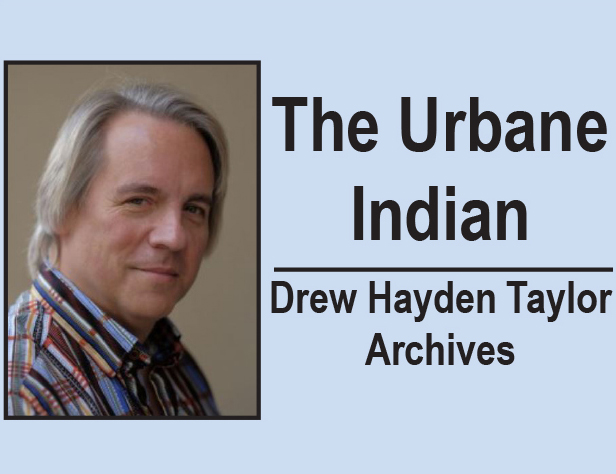
By Drew Hayden Taylor
Originally published in September 2011
Being an Elder is not easy. Not that I know personally, but I’ve heard rumours. It’s both a vocation and a dedication. It’s a position that requires you to be smart. You also have to be empathic. A good sense of humor also helps, as well as excellent communication skills.
These are the differences between somebody who is an Elder, and somebody who is just old. And all of these talents have to come from years of experiencing life and adding life to experiences.
And in these complex times, it can also be a mine field of sorts because another Elder responsibility is bridging the gap between the old ways and the new ways. Between the way things used to be, and the way things are becoming.
This is not as easy as it sounds. What do you do when some of these traditional beliefs may, unknowingly, not be so beneficial to others and, in fact, are counter-productive?
Now that’s a provocative question worthy of much discussion. For example, take the concept of traditional circles, long a part of Native practice. After a talking or healing circle has ended, it is usually customary to hug other members as a way of ending the shared communication on a positive note.
Some Elders are quite adamant about this exercise. What’s wrong with a hug?
To some, a lot.
There are people out there who go to these circles who have been the victims of sexual and physical abuse and who are looking for healing. As a result, they are severely and understandably uncomfortable with such repeated and sustained physical contact. They may shy away from such healing circles as a result.
Also, in our modern multi-cultural world, we are inviting more and more people from other lands and cultures into our circles because the teachings are universal. I have heard people talk of Muslim women attending such gatherings. And, as is commonly known, it is essentially forbidden for a non-related man to touch, let alone hug, a Muslim woman.
It’s a multi-faceted world getting ever more and more complex.
Let me give you another example. There are few things as ‘traditionally Native’ as the practice of smudging. To the uninitiated, smudging is the act of cleansing/purification through the use of burning sweetgrass (usually in braided form) or sage (held in an abalone shell or simple small clay pot).
With your hands, you wash the smoke over your head and body as you silently reflect upon yourself, your actions, and your place in the world. Essentially, most of Canada’s First Nations practice variations of this spiritual and honored tradition.
With all spiritual and sacred traditions there are certain rules that have to be observed.
Perhaps the most stringent and obvious of these rules is that anybody involved with the smudging, either the smudger or the smudgee, is not to have been in contact with drugs and alcohol for a set period of days prior to the smudging.
With substances like that being the scourge of many Aboriginal societies, this is considered disrespectful and you will have your Aboriginal behinds metaphorically paddled for showing up in such a state. Or you’ll at least be asked to abstain from participating.
Conventional traditional beliefs teach that our sacred medicines should never come into contact with drugs or alcohol.
This is where things get interesting.
Most ceremonies in the Native community follow this strict guideline religiously (pun intended). A hard and fast rule, or so I thought. Evidently there are Elders out there fudging (or is it smudging) this line, with good, logical reasoning.
There is one Elder I know that not only accepts those with substance abuse problems into her circle, she even welcomes them in whatever state of consciousness or sobriety they may show up in. She doesn’t see it as being disrespectful. She sees it as more of a cry for help or demonstration of need.
And since helping the needy is what she does (it’s on most Elder’s job description), it would seem silly for her to turn them away for such a transgression. It is these people in particular, she feels, that need the medicines –sage, sweetgrass, cedar and tobacco – more than most people.
Furthermore, she doesn’t want to contribute towards the marginalization of these already disenfranchised people and chooses instead to be inclusive. This is a very controversial position to take.
Paraphrasing, she asks “Do people actually believe the medicines are too weak and vulnerable in the presence of alcohol and drugs? This is one of the things they are meant to fight.”
Interesting question.
It seems there’s more to being an Elder than just a cup of tea and a knowing smile.
